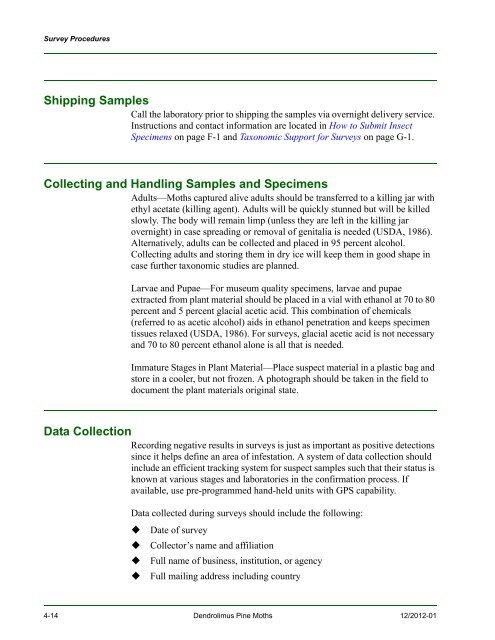New Pest Response Guidelines - aphis - US Department of Agriculture
New Pest Response Guidelines - aphis - US Department of Agriculture
New Pest Response Guidelines - aphis - US Department of Agriculture
Create successful ePaper yourself
Turn your PDF publications into a flip-book with our unique Google optimized e-Paper software.
Survey Procedures<br />
Shipping Samples<br />
Call the laboratory prior to shipping the samples via overnight delivery service.<br />
Instructions and contact information are located in How to Submit Insect<br />
Specimens on page F-1 and Taxonomic Support for Surveys on page G-1.<br />
Collecting and Handling Samples and Specimens<br />
Adults—Moths captured alive adults should be transferred to a killing jar with<br />
ethyl acetate (killing agent). Adults will be quickly stunned but will be killed<br />
slowly. The body will remain limp (unless they are left in the killing jar<br />
overnight) in case spreading or removal <strong>of</strong> genitalia is needed (<strong>US</strong>DA, 1986).<br />
Alternatively, adults can be collected and placed in 95 percent alcohol.<br />
Collecting adults and storing them in dry ice will keep them in good shape in<br />
case further taxonomic studies are planned.<br />
Larvae and Pupae—For museum quality specimens, larvae and pupae<br />
extracted from plant material should be placed in a vial with ethanol at 70 to 80<br />
percent and 5 percent glacial acetic acid. This combination <strong>of</strong> chemicals<br />
(referred to as acetic alcohol) aids in ethanol penetration and keeps specimen<br />
tissues relaxed (<strong>US</strong>DA, 1986). For surveys, glacial acetic acid is not necessary<br />
and 70 to 80 percent ethanol alone is all that is needed.<br />
Immature Stages in Plant Material—Place suspect material in a plastic bag and<br />
store in a cooler, but not frozen. A photograph should be taken in the field to<br />
document the plant materials original state.<br />
Data Collection<br />
Recording negative results in surveys is just as important as positive detections<br />
since it helps define an area <strong>of</strong> infestation. A system <strong>of</strong> data collection should<br />
include an efficient tracking system for suspect samples such that their status is<br />
known at various stages and laboratories in the confirmation process. If<br />
available, use pre-programmed hand-held units with GPS capability.<br />
Data collected during surveys should include the following:<br />
Date <strong>of</strong> survey<br />
Collector’s name and affiliation<br />
Full name <strong>of</strong> business, institution, or agency<br />
Full mailing address including country<br />
4-14 Dendrolimus Pine Moths 12/2012-01

















